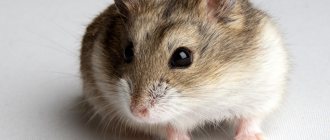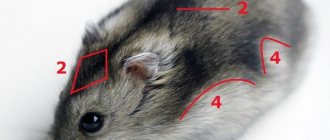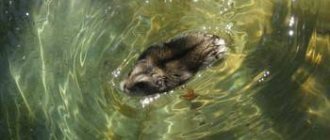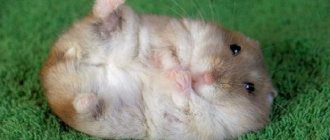Roborovsky's hamster
Roborovsky hamsters are very small compared to other hamsters. They are named in honor of the traveler scientist V.I. Roborovsky, who first discovered them in Tibet at the beginning of the last century. However, for the first time in the discoverer’s homeland they appeared only in the second half of the 20th century. It is noteworthy that the species practically did not manage to take root in European countries.
Differences between the Roborov hamster and the Djungarian hamster:
| Roborovskys | Dzungarian |
| The smallest representative, 4-5 cm long. | They reach a size of up to 10 cm. |
| Difficulties arise with reproduction. | They reproduce well. |
| Pugnacious with neighbors in a cage. | No problems with other hamsters. |
| At home they can live up to 4 years. | On average they live about 2 years. |
| Uniform fur color, except for the white belly and eyebrows. | There is a dark stripe on the back, and a diamond-shaped stripe on the head. |
| Due to the difficult conclusion, they are very rare. | One of the most common types of hamsters. |
| The most expensive in terms of price. | The cost is several times less for Roborov hamsters. |
| They usually do not bite, only in rare cases. | They also rarely bite, but it hurts more than the Roborovsky ones. |
| They have a snub-nosed muzzle. | The Dzungarian species has a sharp muzzle. |
| Hard to tame. They are afraid of sudden movements and loud sounds. They may faint. | They are not afraid of people and quickly get used to them. |
| This species is not suitable as a pet for children. | Ideal pets for children. |
| Due to their small size, they can squeeze through holes in the cage. Must be kept in special containers made of glass and plastic. But due to their size, they do not require huge cages to contain them. | Contained in ordinary cages. |
| They are clean and have no unpleasant odor. | There is an unpleasant odor if not properly cared for. |
| They practically don’t get sick. | Sometimes they get sick, but not often. |
Distinctive features of the species
- The length of the body is 4–5 cm. For comparison: the Djungarian hamster has a body length of up to 10 cm, a tail of up to 1.8 cm.
- The weight of an adult is 22–26 grams.
- The coat is soft and fluffy, longer than that of other dwarf hamsters.
- Wide head with upright large gray ears.
- Large round black eyes.
- A miniature tail that is almost hidden in the thick fur.
- Flattened muzzle.
- 4 toes on the front paws, 5 on the hind paws.
- The soles of the paws are covered with hair.
- Excellent vision.
- Despite the habit of stockpiling, there is no need to hibernate.
- Good harmony with relatives of the same sex.
- It bites extremely rarely and is almost painless.
- They become sexually mature approximately 18-20 days after birth.
- The number of hamsters in a litter is on average from 3 to 5 (in very rare cases up to 6 – 7).
- They are not used in laboratory research due to their more difficult breeding in captivity than other hamsters.
- Very active temperament: constantly on the move, scurrying around, fidgeting, unable to sit quietly in his arms.
Interesting: thanks to the enormous contribution of Russian zoologists to the breeding of dwarf hamsters, representatives of this breed are usually called “Russians”. The Roborovsky hamster is also often called the winter white hamster.
What does a hamster look like?
The smallest hamsters are sand-colored, with no additional stripes or markings on their fur. At the very roots, the color of the fur is darker than grayish. This color is considered natural, which occurs in nature. In addition to their natural color, there are hamsters with cream-colored fur.
The color is not uniform; on the belly and near the antennae it is very light, almost white. Sometimes you can see a rare color in the form of white fur on the entire face. The ears are gray.
Behavior
Roborov hamsters are very pugnacious. Same-sex individuals can still somehow get along and live in peace. Animals of different sexes, even though they give birth to offspring, will fight constantly. They are very active both at night and during the day, it is interesting to watch them, the main thing is not to scare them.
It is not recommended to add a new pet to hamsters that have lived together for a long time. They will begin to offend the newcomer, will not accept him and are unlikely to become friends in the future.
Roborovian hamsters are very shy, which makes them almost impossible to tame. Any loud noise can frighten them greatly. You should not laugh or shout loudly near them.
How to distinguish a Roborovsky hamster from a dwarf hamster
Despite the noticeable differences in the size of the body and tail, representatives of these two breeds are sometimes confused. This does not threaten people who understand. However, for amateurs (and there are about 90 of us) it is better to know the main characteristics of the Roborovsky hamster and its difference from the dwarf hamster. At least in order to better understand who is offered to us in the pet store.
The Roborovsky hamster differs from the Djungarian in the following ways:
- The dzhungarik has a dark stripe running down its back, forming something like a diamond on the top of its head. The Roborovsky hamster has no stripes at all.
- Dzungarik is a little larger. The size of an adult Djungarian hamster is on average no more than 8 centimeters. Roborovsky's hamsters - maximum 5 cm. Don't worry, you won't have to go to pet stores with a ruler. It is enough to see them together once to notice this difference in size by eye in the future.
- Roborovsky's hamster is less willing to make contact. If you see that the baby is asking to come to you, it means that this is a representative of the breed that is sick in the head. Or is it just a different hamster. These differences are enough for amateurs. Remember these 3 points and you will not have any problems understanding where the Djungarian hamster is and where the Roborovsky is.
Now, knowing all this information, take a look at the title photo of the article (the largest one, where there are 3 hamsters). The most attentive of you will easily find a Djungarian hamster there. I specially made a collage of photographs of different breeds to make the differences between them clearer. You can even leave a hint in the comments for those who do not have such keen eyesight.
Roborovsky hamster cage
Due to the fact that Roborovian hamsters are small, it is not recommended to keep them in a cage with large holes. They will escape through the bars of standard cages. To keep them, you need cages with closely spaced bars or special glass or plastic cages.
The cage should have an area of 80 by 60 cm. The pet must have a running wheel with a diameter of about 20 cm. Since the animals are very active, they must spend their energy somewhere, otherwise they will quarrel with all their neighbors if they do not live alone. Roborovsky hamsters love to hide, so it is necessary to provide them with different types of shelter in the cage in the form of houses, holes and tunnels.
You need to pour sand or sawdust in a layer of about 3 cm on the floor of the cage. If you have baby hamsters, you definitely need to make a separate shelter for them. Small branches, grass, hay or moss are suitable for this. The main thing is to create comfortable conditions. Place a container for food on the floor, a separate container for water and a mineral stone. Place a tray in the corner of the cage. Hamsters can be trained to go to the toilet if desired, but this must be done while they are still babies.
What to feed a Roborovsky hamster
Roborov hamsters are not picky eaters. Their diet is practically no different from that of other breeds. Pets are fed special prepared food consisting of grain crops, various types of seeds, and corn. In addition, they love to feast on vegetables and fruits.
It is necessary to try to diversify the diet of hamsters. It's good for their health. In addition to fruits and vegetables, it is necessary to give more greens, they love them very much. Some owners advise feeding their pets bread soaked in milk.
Foods that hamsters are recommended to eat:
- millet;
- grain feed;
- vegetables and fruits;
- wheat (must be sprouted);
- fresh chicken (necessarily without salt);
- fish (not salted);
- white bread, pre-soaked in milk;
- porridge from buckwheat, rice, millet and oatmeal;
- light low-fat cottage cheese;
- low-fat sour cream;
- eggs (it is recommended to give quail and chicken);
- not hot or spicy greens (lettuce, dandelion).
Foods that should never be fed to hamsters:
- products containing cocoa powder;
- salty and sweet foods;
- seasonings, herbs and spices;
- any canned food and pickled vegetables;
- Fruit seeds and seeds are strictly contraindicated;
- semi-finished products;
- pine nuts and almonds;
- cabbage and tomatoes;
- semi-finished products;
- sour (citrus) and astringent (persimmon) fruits;
- food from a person's table;
- garlic and onion;
- dirty, stale, cold and hot food.
Particular attention is paid to the diet of pregnant and lactating hamster mothers. At this time, her body is in great need of protein, so she is fed fresh white chicken meat, fish without salt and mealworms.
Babies, like mothers, also need protein while growing. Therefore, they are fed chicken or quail eggs, fish, mealworms, cottage cheese and porridge.
Hamsters recover quickly, so it is necessary to monitor how much fat, protein and carbohydrates they consume. You need to make sure your pet moves more often. A running wheel and dietary restrictions will help him get back to normal.
Possible troubles
The life of robos is short (no more than 2 years) and fleeting. Increased metabolism also contributes to the rapid development of the disease. If there is a suspicion of its occurrence, then immediately contact a specialist. It is advisable to find out in advance who exactly knows how to treat hamsters.
Dwarfs often have fractures, which is associated with their activity or improper organization of space. Usually the bones heal quickly, but during the recovery period the wheel and other attractions are removed and the baby is provided with peace.
Do hamsters hibernate? Often, owners observe a picture when their pet does not move and seems to have died. Most likely, the hamster is numb from the cold. It will be enough to warm it in your palms and warm the room to a temperature of 21 ° C for the pet to come to life again and run around happily.°
How to care
Roborov hamsters are very freedom-loving and capricious. Therefore, their survivability in the wild is very high. It is at home that hamsters more often prevail in stressful conditions. They get scared by strong sounds and even faint. It is worth taking care of their health and not making noise near their cage. They avoid human hands and do not like to be touched or petted.
It is not recommended to take them out of their cages. If the hamster managed to escape from the cage or from the hands of the owner, it is worth catching it with the help of harmless traps, luring it with its favorite food.
Due to their small stature, the animals practically do not climb the walls of the cages, so keeping them in glass and plastic cages will not be stressful for them. In this case, it is very important to create well-ventilated conditions. It is better to purchase plastic containers for keeping hamsters. In glass containers, the walls fog up and an unfavorable atmosphere is created for the life of pets, but favorable for the growth of microbes and bacteria.
You cannot smoke near your pet’s cage or place its cage in drafts. It is necessary to protect hamsters from living near areas of mold and dampness.
You need to clean the cage several times 2-3 times a week, change the sand and sawdust when they become dirty. Every day, be sure to clean the feeder and change the water to clean water.
For the toilet, you need to purchase a special tray and filler for it. It also needs to be cleaned so as not to spread germs and the pet does not get sick.
Maintenance and care
A 2-3 centimeter layer of fine sand, preferably quartz, is poured onto the bottom of the cage.
You can use large sawdust. Among the accessories: a house, a wheel, a tray, a mineral stone, a feeder and a drinking bowl, you need to lay out small branches of fruit trees, a couple of stones, a little hay or moss. For a pair of rodents you will need an area measuring 70 cm * 50 cm, two wheels of at least 18 cm in diameter, each with a separate house (this type of hamster is very fond of all kinds of shelters). Since the hamster is miniature and almost never climbs the bars of the cage, it is possible to keep it not in a cage, but in a plastic container (dune). A glass aquarium is not the best solution due to fogging of the walls (a favorable environment for the growth of bacteria). A place to live must be chosen taking into account the fact that hamsters cannot tolerate places where they smoke, drafts, dampness, or too hot or cold air.
The water in the drinking bowl must be changed daily, even if the hamster has not drunk it, and the feeder must be washed regularly. Cleaning does not take much time and is required about a couple of times a week or as the sand gets dirty.
Be sure to purchase a toilet tray for your hamster and a special filler for it. This will make cleaning easier and completely eliminate unpleasant odors. You need to toilet train your hamster from an early age; later it will be impossible to retrain it.
Otherwise, the conditions for keeping the Roborovsky hamster do not differ from caring for other types of hamsters.
Reproduction
Hamsters are known for their fertility, but this does not apply to the Roborov breed. A litter of this breed can produce a maximum of 5 babies, but usually the number is much less.
Before breeding a pair, it is imperative to introduce the hamsters and let them become friends, or better yet, form a pair from a very early age. A lattice partition is placed in the cage with pets and the hamsters are protected from each other. This will give you the opportunity to get used to each other and not fight.
To properly breed Roborov hamsters you need to know the following:
- You need to form a pair at 4 months of age;
- females become pregnant on the day of mating, pregnancy lasts about 23 days;
- a pregnant female should not be touched or disturbed; it is better to isolate her from other relatives;
- labor can last up to 2 hours;
- babies are born deaf, blind and without hair, weighing 1 gram and height 1 cm;
- a woman in labor after childbirth is very angry and pugnacious;
- In no case should you touch newborns with your hands unless you can do without it; it is better to use a foreign object for this;
- after 25 days you can separate mother and babies.
Babies may need complementary feeding. It is necessary to feed them protein foods during growth. Usually they are given fish, eggs, cottage cheese.
Breeding at home
Pairs need to be formed in infancy. If this was not possible, then the adults should be given time to get used to each other. At the pet store you can purchase a special grid for the cage, which will allow the animals to sniff, but not make contact, this will eliminate conflicts. The grate is removed after eight to ten days.
The duration of pregnancy is 25 days. At this time, you should not disturb the pregnant woman; she may show aggression and bite. Pay special attention to nutrition; your diet should be as varied as possible. Arrange her home properly. Give the opportunity for privacy; for this purpose, install an individual house, or better yet two. Pour some sawdust, and with their help the expectant mother will make a nest for her offspring.
Female Roborovskis are not as fertile as females of other species. The litter does not exceed six cubs. Hamsters are born hairless and blind. After a week of life, their bodies become covered with fluff. They become independent within two weeks. Baby purees and cereals are suitable as complementary foods. It is better to hold off on fruits and herbs so as not to cause loose stools in babies.
How to tame
To tame a Roborov hamster, you need to take the following steps:
- The hamster must get used to its owner and trust him. To do this, the owner needs to give him food himself. Quiet, calm conversations will allow the animal to get used to the owner's voice.
- Offer hand-held treats daily. When the animal begins to approach without fear, place the treat in your palm.
- When the hamster gets used to treats served in this way and begins to eat them while sitting on your hand, you can slightly lift it and offer the treat in this position.
- Then start stroking him a little each time. Repeat until the hamster stops being afraid and allows himself to be petted without the offered treat.
Do not shout at the animal or grab it by the fur from above. Such actions will only scare him away.
What is the price
Roborovsky hamsters are more expensive than other types of hamsters. The price depends on the rarity of the species and the complexity of their breeding. The lowest price is 500 rubles. But it is better to buy from special nurseries with documents for the animal. They cost about 1000 - 1500 rubles.
Irina Ivanishchena
I am engaged in professional breeding of hamsters and rats on an ongoing basis. I know something about them that most people don’t know. Always open to constructive discussion
Post Views: 1,692











